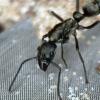Genus:
- Lasius
- Formica
- Camponotus
- Polyergus
I am going to try to present you how to distinguish between some close related genus of the ants in Formicinae subfamily.
Formicinae is subfamily of “modern” ants, there’s several genus in this subfamily, but most common are Lasius, Formica, Camponotus and Polyergus. Most species names are coming from Latin (lingua latīna) language, like Formica s.str. pratensis where word Formica is Greek word for “ant”; s.str. is short for sensu stricto Latin – “in strict sense”; pratensis lat. for “meadow”.
Sensu stricto in this contest means strictly wood ant or true wood ant.
Most common genus of ants in this subfamily is Lasius. They are covering most of the world. Workers of this genus are only few (3 to 5.5) millimeters while queens can be about 1cm.
Lasius are very similar to Formica and only few details will help to distinguish between this two genus.
Generally, all Formica members (workers) have hairy and round gaster. Gaster can be stretched if it’s full but then each tergite will be distinguished. Head of ants in this genus is almost twice width of thorax. Propodeum is not wider than pronotum.
Lasius however have big and peaked gaster on bottom, small convex head, just a little bit wider than widest part on thorax. Propodeum is wider than pronotum or same width.
Intervals between head-thorax-petiole-gaster in Lasius genus is very small except for Lasius emarginatus which can be very easily confused for Formica.
Formica members, usually are from about 4.5mm to 10mm while Lasius are up to 5.5mm.

(Formica worker and Lasius worker thorax compare.)
Queen of Lasius (except parasites) have smallest head, compared to thorax and thorax, then gaster. Head is not wider than thorax. Gaster have length of head and thorax together.
It is very important to note that Lasius sp. can be confused for Brachymyrmex sp. queens.
Head of Formica’s queen is wider or same than her thorax. Gaster is widest or same as thorax.


(Lasius flavus and Formica (serviformica) balcanina queens.)

(Formica fusca fusca queen, dead.)

(Formica sensu stricto pratensis queen.)
On F. fusca and F. pratensis queens photos you can note that gaster of sensu stricto queen is smaller and more round. From dorsal view, gaster of Formica sp. can look like spehere. Also, Formica (serviformica) sp. queens have larger compound eyes.
After I’ve described differentiations between Formica and Lasius genus, it’s time to talk about Camponotus.
Identification of carpenter ants is relatively easy ad they are quite unique. There are easily noticeable differentiations between species within genus and most of all, they are usually largest ants.
Camponotus genus is present everywhere from Australia, over Micronesia, Asia, Europe and Africa and both America.
Camponotus genus is polymorph. Big and super big workers have huge heads, some about 3-4mm wide.

(Camponotus vagus queen with nanitics.)
Queen of Camponotus in appearance is long, head is wider than thorax and have shape of major worker, just little bit smaller with some species.
Thorax is long, strong and very high. Gaster is oval shaped.
Antennal fossa – base of antennas is slightly shifted up comparing to Formica and Lasius antennal bases which are just above clypeus.

(Camponotus worker profile.)

(Polyergus rufescens queen.)
Polyergus is one truly unique genus. Polyergus ants are well adopted for fight, they are actually just a raiders, they can’t even raise own brood without help of slave ants. Unlike Formica (raptiformica) sanguinea who enslave all other species in Formica genus, Polyergus enslave only Formica (serviformica) group of ants and they are mandatory parasites.
There’s only one species of Polyergus in Europe, but they are more species around the globe.
Same as Formica, Polyergus is inhabiting only north hemisphere.
Thorax of worker is lot similar to thorax in Formica. Worker has strong pronotum and propodeum, while mesonotum is really small.
Thorax of queen is really small, and it’s obvious that they are strictly parasites.
Petiole is very plump, bottom of clypeus is flat, mandibles are sharp without teeth as with other ants. Top of antennas are sharp.
Head is wider than thorax in both queen and worker form.

(Polyergus sp. and Formica sp. compare.)
Author: Vedad Karavdić a.k.a. wook
Photo and Illustration: Vedad Karavdić and friends.























